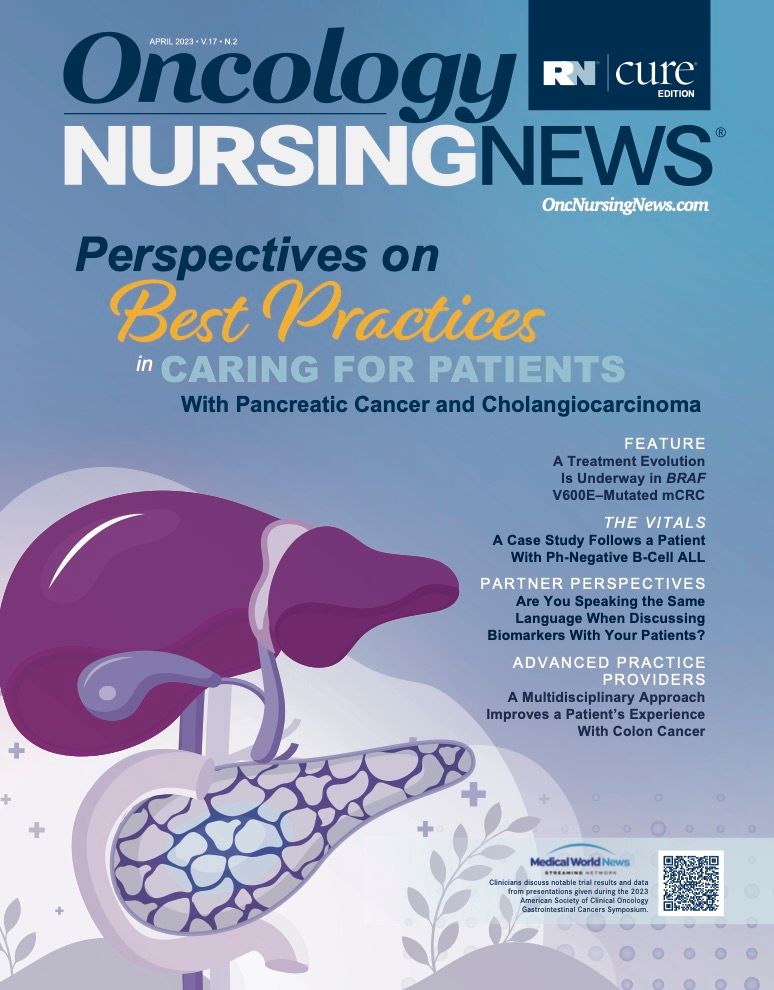A Multidisciplinary Approach Improves a Patient’s Experience With Colon Cancer
Early coordination with multiple specialty teams can maximize outcomes and improve quality of life for patients with complex metastatic disease.
John Lewandowski, PA-C, MS

The most common site of distant metastases in colon cancer is the liver, with 20% to 35% of patients presenting with liver disease when receiving a diagnosis and up to 70% of patients with liver disease at death.1 With only a slim majority of patients being candidates for up-front liver resection, newer treatment modalities are presenting clinicians with options to get better hepatic disease control.
One of the liver-directed therapy (LDT) options is selective internal radiation therapy (SIRT).1-3 This technique uses radiolabeled microspheres that contain yttrium-90 (Y-90), a radioactive isotope delivered through an infusion to the tumors in the liver via the hepatic arteries. The beads help cut off the blood flow to the tumor, and Y-90 releases radiation energy that can damage and shrink tumor cells. Results from studies have shown a progression-free survival (PFS) benefit with this treatment approach for patients with liver-dominant metastatic disease. In addition, patients achieve better response rates when SIRT is used early in treatment.2 In one study of 68 patients with colorectal liver metastases, those who received SIRT after frontline chemotherapy experienced a median PFS of 9 months, whereas patients who received it after 2 or more lines of chemotherapy experienced a median PFS of 3 months.
Patient Case
A 28-year-old woman, Mrs A, presented to her primary care physician in summer 2020 with rectal bleeding. She had just given birth to her second child and chalked up her symptoms to hemorrhoids related to her pregnancy. When at-home remedies failed to improve her symptoms, she tried to make an appointment with a gastroenterologist several times but ran into issues scheduling an in-person consultation because of pandemic restrictions. She was eventually seen, and results from a colonoscopy revealed a partially obstructing rectosigmoid mass that biopsy results proved to be invasive adenocarcinoma. Genetic testing showed negative results for any pathogenic mutations. Initial staging imaging revealed metastatic lesions in her liver and both lungs. Genomic testing showed the following characteristics: a PD-L1 score above 1%, microsatellite-stable disease, a tumor mutational burden score of 5.8, and mutations in APC, PIK3CA, p53, and KRAS. She was therefore not a candidate for immunotherapy or anti-EGFR therapy.
Mrs A began treatment close to home and initially received leucovorin calcium, fluorouracil, and oxaliplatin plus bevacizumab (Avastin). She received this regimen from August 26, 2020, through December 30, 2020. This was followed by maintenance 5-fluorouracil plus bevacizumab from January 2021 through August 2021. Restaging imaging in July 2021 revealed a slight progression in her pulmonary metastases, and she consequently switched to treatment with leucovorin calcium, fluorouracil, and irinotecan hydrochloride (FOLFIRI) plus bevacizumab in August 2021, which she continued until June 2022.
In June 2022, she consulted our hospital, City of Hope Atlanta, in Newnan, Georgia, for a second opinion about treatment options. After our PET scan results demonstrated stable metastatic lesions in her liver and lungs, we placed a consultation for interventional radiology to evaluate her for LDT options, given the stability of her disease elsewhere. Her oncology care team deemed Mrs A to be an acceptable candidate. Mrs A underwent Y-90 radioembolization to the right lobe of her liver in August 2022. She tolerated the procedure well, with some abdominal pain that lingered for approximately a week after treatment, which is very common. MRI in October 2022 noted multiple areas of necrotic tissue in the liver representing managed lesions. She will continue to have follow-up MRIs every 3 months, and if any new lesions develop, there are other LDT options we can consider.
Unfortunately, Mrs A presented to urgent care with intractable right hip pain, and our team found a metastatic lesion in the proximal diaphysis of her right femur on x-ray. Our pain management team has been an important part of her treatment process from the beginning, and they addressed her abdominal pain with oral analgesics and a hypogastric plexus nerve block. She also experienced extreme sacroiliitis pain due to her rectal tumor, which prompted our pain management department to perform a sacral ganglion impar nerve block. We then consulted the radiation oncology team regarding her new femoral lesion. She had previously received palliative radiation to her rectal mass for pain control in April 2020. After discussing her case with the orthopedics team, we prophylactically inserted an intramedullary rod to prevent later pathologic fracture during radiation treatment.
Mrs A has been and continues to be involved in a variety of treatment modalities, which can have physical, social, and emotional consequences. From my perspective working in medical oncology, our treatments have their advantages—helping patients live longer and better lives—but come with certain considerations, such as potential long-term and debilitating adverse effects. For Mrs A, fatigue and nausea were the biggest complaints, and we had to make changes to her treatment regimen to help alleviate some of these effects. She has been on FOLFIRI/bevacizumab since June 2022 and continues to receive this regimen today. Her disease is stable, and we continue to draw help from supporting departments to manage her metastatic lesions.
Undergoing treatment for metastatic cancer is difficult enough; undergoing treatment as a mother of 2 small children adds complexity and challenges. She continues to follow up with our behavioral health department, which helps her stay focused on treatments and not become overwhelmed with despair. Her children keep her grounded, and she often talks about wanting to stay on treatment for as long as possible for their sake. Mrs A is a shining example of why early consultation with different specialties to create a multidisciplinary, specialized approach can lead to improved coordination of care, maximized quality of life, and better potential outcomes for patients with complex metastatic disease.4,5
References
- Cortesi E, Caponnetto S, Masi G, et al. Efficacy and tolerability of selective internal radiotherapy with yttrium-90 as consolidation treatment after chemotherapy in metastatic colorectal cancer. Clin Colorectal Cancer. 2020;19(4):e272-e276. doi:10.1016/j.clcc.2020.06.008
- van Hazel GA, Heinemann V, Sharma NK, et al. SIRFLOX: randomized phase III trial comparing first-line mFOLFOX6 (plus or minus bevacizumab) versus mFOLFOX6 (plus or minus bevacizumab) plus selective internal radiation therapy in patients with metastatic colorectal cancer. J Clin Oncol. 2016;34(15):1723-1731. doi:10.1200/JCO.2015.66.1181
- Yttrium-90 internal radiation therapy. University of Pittsburgh Medical Center Hillman Cancer Center. Accessed March 10, 2023. https://bit.ly/3YDf0Fi
- Chow FCL, Chok KSH. Colorectal liver metastases: an update on multidisciplinary approach. World J Hepatol. 2019;11(2):150-172. doi:10.4254/wjh.v11.i2.150
- Obias VJ, Reynolds HL Jr. Multidisciplinary teams in the management of rectal cancer. Clin Colon Rectal Surg. 2007;20(3):143-147. doi:10.1055/s-2007-984858




